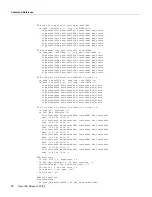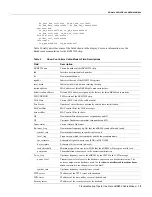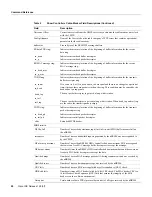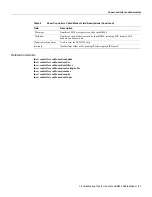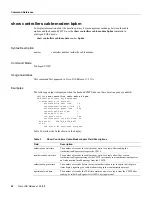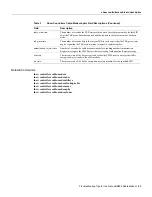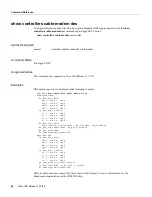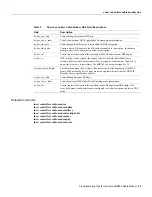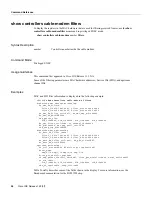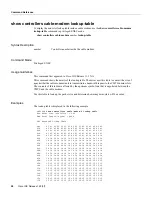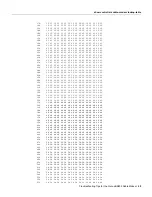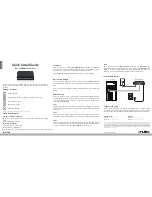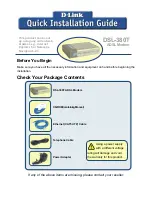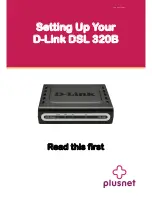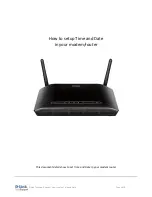
Troubleshooting Steps
14
Cisco IOS Release 12.0(3)T
Event 8
—
Transfer Operational Parameters
After the DHCP and security operations are successful, the cable modem downloads operational
parameters from the cable company’s TFTP server. These parameters are transferred via a
configuration file. The field
CMAC_LOG_DHCP_CONFIG_FILE_NAME
shows the filename containing the
transmission parameters.
508177.164 CMAC_LOG_STATE_CHANGE configuration_file_state
508177.166 CMAC_LOG_LOADING_CONFIG_FILE platinum.cm
508178.280 CMAC_LOG_CONFIG_FILE_PROCESS_COMPLETE
Event 9
—
Perform Registration
The cable modem registers with the headend Cisco uBR7246. After the cable modem is initialized,
authenticated, and configured, the cable modem is authorized to forward traffic into the cable
network. A successful registration is indicated by the field
CMAC_LOG_REGISTRATION_OK
.
508178.300 CMAC_LOG_STATE_CHANGE registration_state
508178.302 CMAC_LOG_REG_REQ_MSG_QUEUED
508178.306 CMAC_LOG_REG_REQ_TRANSMITTED
508178.310 CMAC_LOG_REG_RSP_MSG_RCVD
508178.312 CMAC_LOG_COS_ASSIGNED_SID 1/2
508178.314 CMAC_LOG_RNG_REQ_QUEUED 2
508178.316 CMAC_LOG_REGISTRATION_OK
Event 10
—
Comply with Baseline Privacy
Keys for baseline privacy are exchanged between the cable modem and the headend Cisco uBR7246.
During this event, a link level encryption is performed so that a user’s data cannot be “sniffed” by
anyone else who is on the cable network.
Following is a trace that shows baseline privacy enabled. The key management protocol is
responsible for exchanging two types of keys: KEKs and TEKs. The KEK (key exchange key, also
referred to as the authorization key) is used by the headend CMTS to encrypt the TEKs (traffic
encryption keys) it sends to the cable modem. The TEKs are used to encrypt/decrypt the data. There
is a TEK for each SID configured to use privacy.
851.088 CMAC_LOG_STATE_CHANGE establish_privacy_state
851.094 CMAC_LOG_PRIVACY_FSM_STATE_CHANGE machine: KEK, event/state:
EVENT_1_PROVISIONED/STATE_A_START, new state: STATE_B_AUTH_WAIT
851.102 CMAC_LOG_BPKM_REQ_TRANSMITTED
851.116 CMAC_LOG_BPKM_RSP_MSG_RCVD
851.120 CMAC_LOG_PRIVACY_FSM_STATE_CHANGE machine: KEK, event/state:
EVENT_3_AUTH_REPLY/STATE_B_AUTH_WAIT, new state: STATE_C_AUTHORIZED
856.208 CMAC_LOG_PRIVACY_FSM_STATE_CHANGE machine: TEK, event/state:
EVENT_2_AUTHORIZED/STATE_A_START, new state: STATE_B_OP_WAIT
856.220 CMAC_LOG_BPKM_REQ_TRANSMITTED
856.224 CMAC_LOG_BPKM_RSP_MSG_RCVD
856.230 CMAC_LOG_PRIVACY_FSM_STATE_CHANGE machine: TEK, event/state:
EVENT_8_KEY_REPLY/STATE_B_OP_WAIT, new state: STATE_D_OPERATIONAL
856.326 CMAC_LOG_PRIVACY_INSTALLED_KEY_FOR_SID 2
856.330 CMAC_LOG_PRIVACY_ESTABLISHED
Note
In order for baseline privacy to work, you must use code image names containing the
characters “k1” on both the uBR904 (the subscriber end) and the uBR7246 (the headend). In
addition, privacy must be turned on in the configuration file that is downloaded to the uBR904.


















